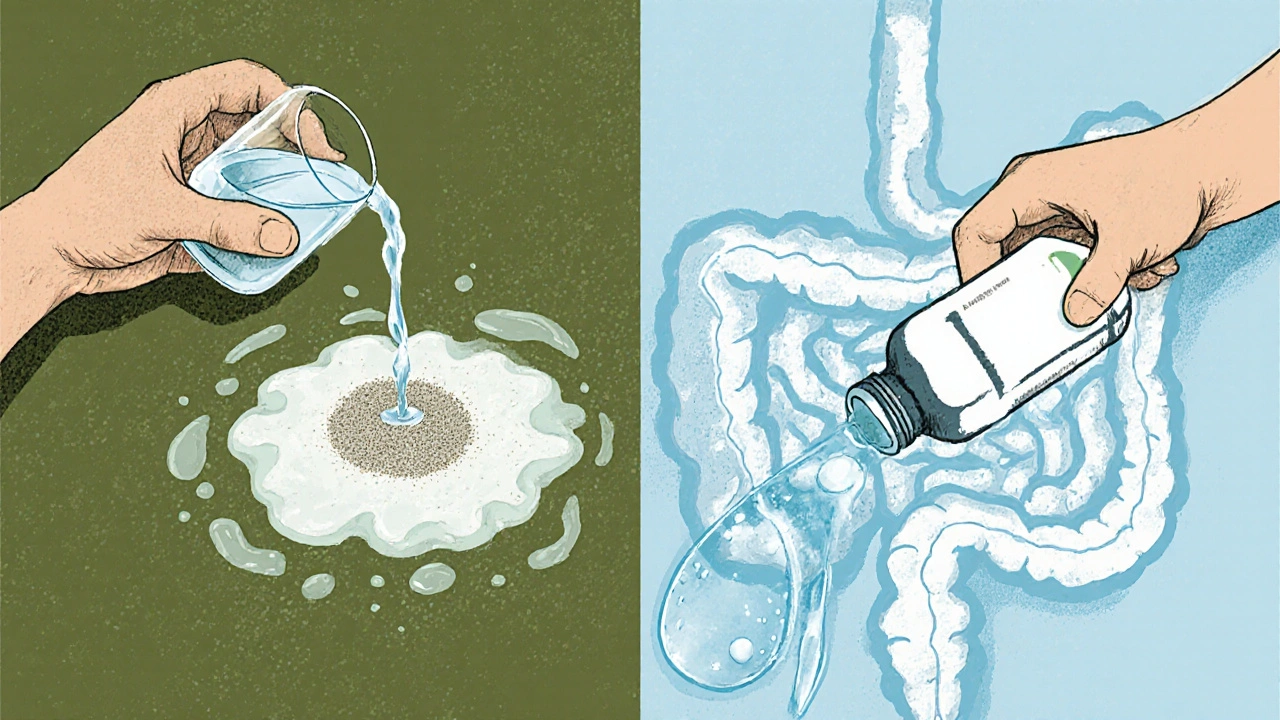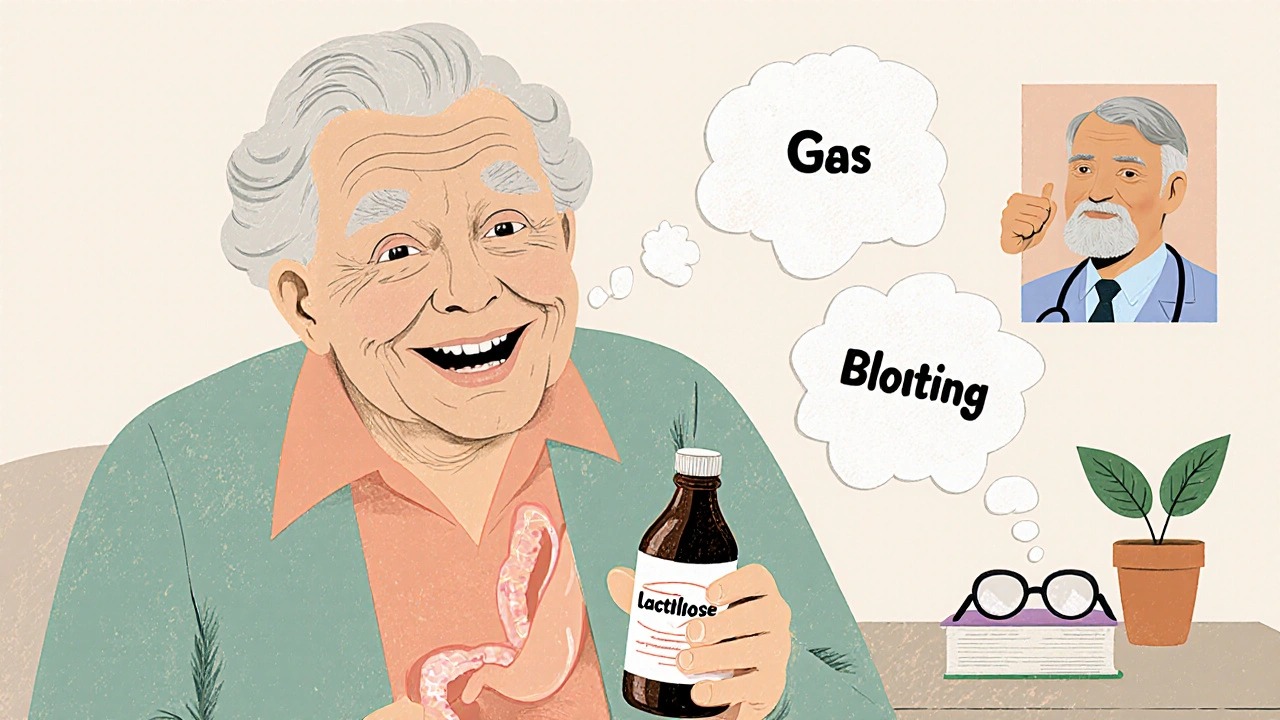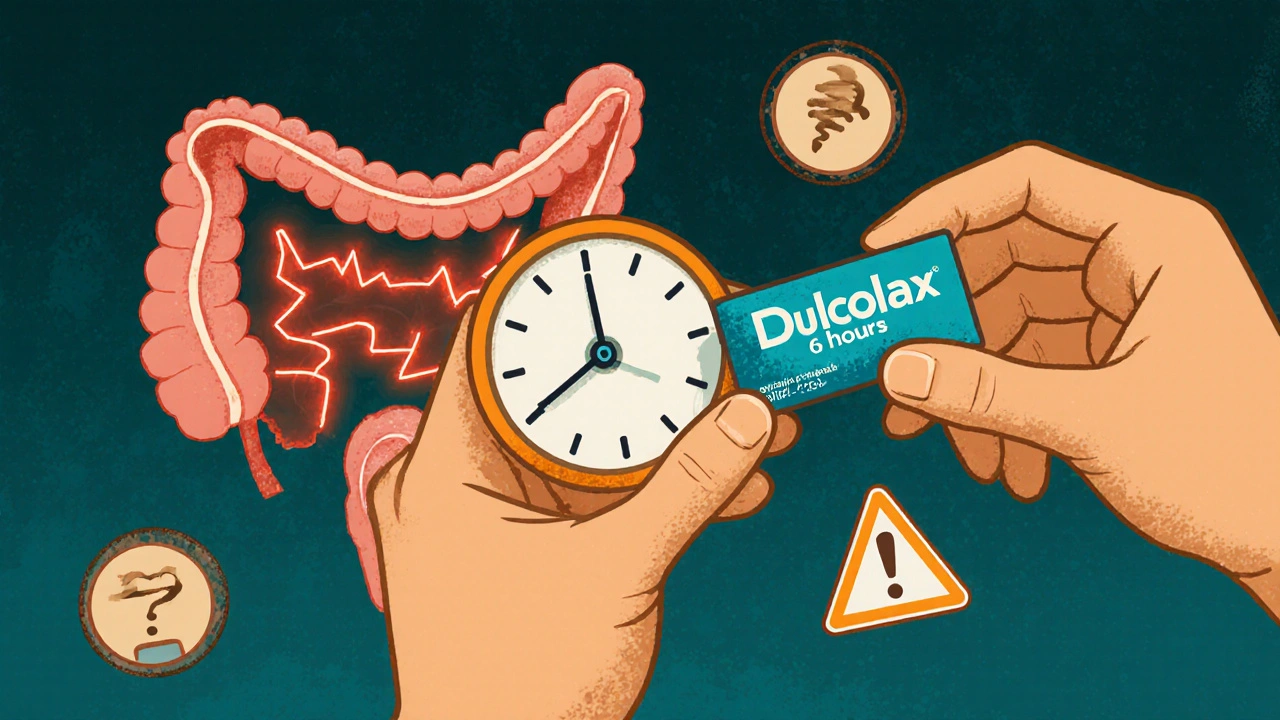Laxative Selector Tool
Your Situation
Results
Select your situation and click "Get Recommendation" to see personalized advice.
Constipation isn’t just uncomfortable-it can feel like your body’s stuck in reverse. If you’ve reached for Dulcolax before, you know it works fast. But what if it doesn’t work this time? Or maybe you’re worried about side effects, or you’ve heard about other options and wonder if they’re better. You’re not alone. People in Melbourne, Sydney, and beyond are asking the same thing: Dulcolax vs the alternatives. Let’s cut through the noise and show you exactly how they stack up.
What is Dulcolax, really?
Dulcolax is the brand name for bisacodyl, a stimulant laxative. It doesn’t just soften stool-it wakes up your colon. Bisacodyl triggers muscle contractions in the intestines, pushing waste out. Most people feel the effect within 6 to 12 hours after taking a tablet, and even faster (as little as 15-60 minutes) if it’s a suppository. That speed is why it’s popular for sudden constipation or before medical procedures.
But here’s the catch: it’s not gentle. Because it forces your bowels to move, it can cause cramps, nausea, or even dizziness in some people. Long-term use? That’s a red flag. Your colon can start depending on it, losing its natural rhythm. That’s why doctors usually recommend it for short-term relief only.
Stool softeners: The gentle alternative
If Dulcolax feels too harsh, you might want to try a stool softener like docusate sodium (Colace, Surfak). These don’t stimulate your bowels. Instead, they let water and fat seep into the stool, making it softer and easier to pass. Think of it like soaking a dry sponge before squeezing it out.
Stool softeners take 1-3 days to work. That’s slower than Dulcolax, but they’re safer for daily use. People on painkillers (like opioids after surgery), pregnant women, or those with hemorrhoids often use them long-term because they don’t cause cramping or dependency.
But here’s the trade-off: if your stool is hard and packed, a softener alone might not be enough. You need the stool to be soft and moving. That’s why some people combine docusate with a small dose of Dulcolax-soften first, then stimulate.
Magnesium-based laxatives: Nature’s electrolyte trick
Magnesium hydroxide (Milk of Magnesia) and magnesium citrate are osmotic laxatives. They pull water into the intestines from surrounding tissues. More water = bigger, softer stool = easier passage.
They usually work in 30 minutes to 6 hours. That’s faster than stool softeners but slower than Dulcolax suppositories. Magnesium citrate is often used for bowel prep before colonoscopies because it clears things out thoroughly.
Pros? No dependency. No nerve stimulation. Just physics. Cons? Too much magnesium can cause diarrhea, dehydration, or electrolyte imbalances-especially in older adults or people with kidney problems. If you’re on heart or kidney meds, check with your pharmacist first.

Psyllium husk: Fiber that actually works
Psyllium (Metamucil, Konsyl) is a soluble fiber. It’s not a drug-it’s ground husks from the Plantago ovata plant. When mixed with water, it forms a gel that adds bulk to stool and gently encourages movement.
It takes 12-72 hours to work. That’s slow, but it’s the most natural option. Studies show regular use improves bowel regularity, reduces straining, and even helps with cholesterol. It’s safe for long-term use, even for kids and seniors.
But here’s the catch: you must drink enough water. Without it, psyllium can swell and make constipation worse. One teaspoon in 250ml of water, twice a day, is the standard. Skip the water? You risk choking or intestinal blockage. It’s not dangerous if used right-but it’s not foolproof.
Lactulose: The sugar-based option
Lactulose is a synthetic sugar that your body can’t digest. When it reaches your colon, gut bacteria break it down, producing acids and gases. That draws water in and stimulates movement. It’s often used for chronic constipation and hepatic encephalopathy (a liver condition).
It takes 24-48 hours to work. That’s slower than Dulcolax, but it’s gentler and doesn’t cause cramping. Many elderly patients tolerate it well. It’s also available as a syrup, which is easier for people who struggle with pills.
Downsides? Bloating and gas are common. Some people say it tastes awful. And if you have diabetes, you need to watch your intake-it’s a sugar, even if it doesn’t raise blood glucose much.
When to skip all of them
Not every case of constipation needs a laxative. If you’re only going every 3-4 days but feel fine, no treatment is needed. The real red flags are:
- Blood in stool
- Unexplained weight loss
- Severe abdominal pain
- Constipation lasting more than two weeks
- Changing bowel habits after age 50
If any of these apply, see a doctor. Laxatives won’t fix colon cancer, thyroid problems, or nerve damage. They’re for symptom relief-not diagnosis.

What works best for you?
Here’s a simple guide based on your situation:
| Option | How it works | Time to work | Best for | Risks |
|---|---|---|---|---|
| Dulcolax (bisacodyl) | Stimulates colon muscles | 6-12 hours (tablet), 15-60 min (suppository) | Fast relief, pre-procedure use | Cramps, dependency with long-term use |
| Docusate sodium (stool softener) | Draws water into stool | 1-3 days | Long-term use, post-surgery, pregnancy | Slower, may need combo with stimulant |
| Magnesium citrate/hydroxide | Pulls water into bowel | 30 min-6 hours | Quick, thorough cleanout | Dehydration, kidney issues |
| Psyllium husk | Adds bulk, forms gel | 12-72 hours | Chronic constipation, daily wellness | Must drink water-risk of blockage if not |
| Lactulose | Fermented by gut bacteria | 24-48 hours | Elderly, liver patients, gentle daily use | Bloating, gas, sweet taste |
If you need something fast-like before a flight or appointment-Dulcolax suppository wins. If you’re dealing with daily sluggishness, try psyllium. If you’re on pain meds and need daily help, docusate is safer. Magnesium is great for occasional cleanouts, but not for daily use.
What most people get wrong
Many think laxatives are interchangeable. They’re not. Taking Dulcolax every day because you’re “not regular” is like using a sledgehammer to open a jar. It works, but you’re damaging the lid.
Another myth: “Natural means safe.” Psyllium is natural, but if you don’t drink enough water, it can cause an obstruction. Magnesium is from the earth, but too much can wreck your heart rhythm. Even “gentle” options have risks if misused.
And don’t assume more is better. Doubling your Dulcolax dose won’t make it work faster-it just increases side effects. Stick to the label.
What to do next
Here’s your action plan:
- If this is your first time with constipation and you’re under 50, try psyllium for 3 days with plenty of water.
- If it’s not working, switch to a stool softener for 2-3 more days.
- If you still haven’t moved, use a Dulcolax suppository-only once.
- If you’re still stuck after that, or you’re over 50, see a doctor. Don’t keep trying stronger laxatives.
Most cases clear up with lifestyle changes: more water, more fiber (oats, beans, veggies), and daily movement-even a 10-minute walk helps. Laxatives are backup tools, not daily crutches.
Can I take Dulcolax every day?
No. Dulcolax is meant for short-term use only-usually no more than a week. Taking it daily can weaken your colon’s natural ability to contract, leading to dependency. If you need daily help, switch to a fiber supplement like psyllium or a stool softener like docusate.
Is Dulcolax better than Miralax?
They work differently. Dulcolax (bisacodyl) is a stimulant-it forces your bowels to move. Miralax (polyethylene glycol) is an osmotic laxative-it pulls water into your colon. Miralax is gentler and safer for long-term use. Dulcolax works faster but carries more risk of cramping and dependency. For chronic constipation, Miralax is usually preferred.
What’s the safest laxative for seniors?
For older adults, psyllium fiber or lactulose are safest. They don’t overstimulate the colon or cause electrolyte shifts. Avoid magnesium-based laxatives if kidney function is reduced. Always start low and increase slowly. If constipation lasts more than a few days, see a doctor-what seems like constipation could be a medication side effect or something more serious.
Can I use Dulcolax while pregnant?
Dulcolax is not the first choice during pregnancy. Stimulant laxatives like bisacodyl can cause cramping and aren’t recommended regularly. Stool softeners like docusate sodium are safer and often prescribed. Always check with your midwife or doctor before using any laxant while pregnant.
Why does my stool still feel hard even after taking a laxative?
If your stool is still hard, you likely need more water or fiber. Laxatives help move things along, but if your stool is dry and compacted, it won’t soften on its own. Combine a laxative with psyllium or increase water intake. If you’re on iron supplements or opioids, those can cause hard stools even with laxatives-talk to your doctor about alternatives.


Jeff Moeller
November 20, 2025 AT 08:02Dulcolax is just your colon being yelled at until it listens
Tyrone Luton
November 21, 2025 AT 06:51People treat laxatives like coffee-like if one cup doesn’t wake you up, two will. But your gut isn’t a smartphone that needs a reboot. It’s a slow, ancient machine that remembers every time you forced it. Long-term stimulants? That’s not medicine, that’s emotional abuse of your digestive system.
You think you’re solving constipation, but you’re just training your body to need a sledgehammer to do what a feather used to do. And when the sledgehammer stops working? Then what? You buy a bigger sledgehammer.
Psyllium doesn’t shout. It whispers. It says, ‘Hey, let’s make this easier.’ And if you listen, your body actually learns how to move again. No dependency. No cramps. Just… rhythm.
But no one wants rhythm. Everyone wants a magic button. That’s why we’re a society of people who take laxatives like they’re energy drinks.
And don’t get me started on magnesium citrate. You think you’re cleansing? You’re just flushing your electrolytes into the toilet like it’s a flushable toilet paper.
Real solution? Water. Fiber. Movement. Not chemicals. Not pills. Not suppositories. Just… life.
But hey, if you like feeling like your intestines are staging a protest, by all means-keep stacking the Dulcolax.
Herbert Scheffknecht
November 23, 2025 AT 01:04Let’s be real-laxatives are just capitalism’s answer to a body that’s tired of being ignored
You think you’re treating constipation, but you’re just medicating the symptoms of a life lived sitting down, eating processed junk, and drinking coffee like it’s oxygen
Every pill is a band-aid on a broken spine
Psyllium is the only thing that doesn’t lie to you-it says ‘you need to move more and drink more’ and you hate that because it’s true
And lactulose? That’s just sugar pretending to be a doctor
Doctors sell you pills because they don’t have time to say ‘go for a walk’
But we all know the real problem: we’re too busy scrolling to notice our own bodies screaming
So we pop a pill, feel better for five minutes, and go back to pretending we’re not falling apart
And then we wonder why we’re always tired
It’s not a gut issue. It’s a soul issue
And no laxative can fix that
Sherri Naslund
November 24, 2025 AT 12:15ok but have u heard about the FDA coverup on bisacodyl?? they banned it in 2018 but the pharma companies just renamed it and sold it as 'dulcolax' again lmao
they dont want you to know that psyllium is 10x cheaper and actually works better
and dont even get me started on how lactulose is just a sugar trap for diabetics
also why do all the 'experts' always say 'see a doctor' but never say 'maybe your meds are the problem'??
my aunt took dulcolax for 3 years and now she cant poop without a suppository
its all a scam
they want you dependent
and the worst part? they make you feel guilty for needing it
like its your fault your colon is broken
no its their fault they sold you poison as a solution
Ashley Miller
November 25, 2025 AT 10:19so you’re telling me the same people who sell you antidepressants also sell you laxatives? and you’re surprised your gut hates you?
every pill is just another way to distract you from the fact that your life is a slow-motion collapse
congrats, you’re not constipated-you’re emotionally backed up
psyllium won’t fix your trauma
but it’ll make you drink water
and maybe, just maybe, that’s the first step toward not hating yourself
Lauren Hale
November 26, 2025 AT 23:57I’ve helped dozens of older patients with chronic constipation, and the most common mistake is thinking one size fits all. Dulcolax is great for a one-time emergency-like before a flight or a colonoscopy. But if you’re using it weekly? You’re not treating constipation, you’re masking a deeper issue.
For seniors, psyllium is gold. Safe, effective, and gentle. Just make sure they’re drinking enough water-so many forget that part. I’ve seen people take psyllium and then wonder why they’re worse. It’s not the fiber-it’s the lack of fluid.
And lactulose? Perfect for people on opioids or with liver issues. It’s slow, but it’s steady. No cramps. No panic. Just… regularity.
Stool softeners are underrated. People think they’re weak, but when paired with movement and hydration, they’re quietly powerful.
And magnesium? Only for occasional use. I’ve seen elderly patients end up in the ER with low potassium because they thought ‘natural’ meant ‘safe in any dose’.
The real hero here isn’t any pill-it’s consistency. Daily walks. More veggies. A glass of water first thing in the morning. These aren’t sexy solutions, but they’re the only ones that last.
If you’re over 50 and this is new? Don’t reach for a laxative. See a doctor. Constipation can be the first sign of something bigger.
And please-stop treating your gut like a broken printer that needs a hard reset.
Greg Knight
November 27, 2025 AT 10:30Look, I get it. You’re busy. You’ve got kids, a job, maybe a side hustle. You don’t have time to soak in a bath and eat chia seeds like some wellness influencer. But here’s the thing-your body doesn’t care how busy you are. It just wants you to move, drink, and eat real food.
So let’s make this simple. Start with psyllium. One teaspoon in water, twice a day. Do it for three days. No excuses. Just do it.
If nothing happens? Add a stool softener for two more days. Still nothing? Fine-use the Dulcolax suppository once. Just once. And then go back to the fiber.
Most people skip the first two steps because they want instant results. But that’s like trying to fix a flat tire by driving faster.
And hydration? It’s not optional. Your body isn’t a desert. It’s a river. If you don’t feed the river, it dries up.
Also-walk. Even 10 minutes after dinner. That’s it. Just move. Your colon isn’t a muscle that needs a gym membership-it needs rhythm.
And if you’re still stuck after a week? Go see someone. Don’t keep doubling down on pills. That’s not bravery. That’s denial.
You’re not weak for needing help. You’re weak for refusing to try the simple stuff first.
Be kind to your gut. It’s been carrying you your whole life.
Martin Rodrigue
November 28, 2025 AT 12:30While the comparative analysis presented is generally accurate, it lacks sufficient reference to clinical guidelines from the American College of Gastroenterology (ACG) and the Canadian Association of Gastroenterology (CAG). Specifically, the ACG recommends osmotic agents such as polyethylene glycol (Miralax) as first-line for chronic functional constipation, not stimulants. Furthermore, the use of bisacodyl for more than seven consecutive days is contraindicated under most clinical protocols due to potential cathartic colon development. The omission of polyethylene glycol from the primary comparison table is a significant oversight, as it is the most evidence-based long-term agent for chronic constipation in both adult and elderly populations. Additionally, the recommendation to use psyllium without emphasizing the necessity of titration and gradual introduction may lead to increased adverse events such as bloating and abdominal distension, particularly in patients unaccustomed to high-fiber intake. A structured, stepwise algorithm incorporating non-pharmacological measures (fluid, fiber, physical activity) before pharmacological intervention remains the gold standard.
Jessica Engelhardt
November 30, 2025 AT 11:21you think psyllium is safe? what about the glyphosate in the fiber? they spray it on the plants before harvest and then grind it into powder and sell it as 'natural' lol
and lactulose? it's made from milk sugar but they don't tell you it's basically a byproduct of industrial cheese factories
and don't even get me started on how the FDA approves laxatives without long-term studies because they're 'over the counter' and don't make enough money to fund trials
you think you're helping your gut but you're just feeding the pharmaceutical machine
real solution? stop eating processed food and move your body
but no, let's just keep buying pills
they want you dependent
and scared
and buying more
Tyrone Luton
December 1, 2025 AT 09:22And you know what’s funny? The people who scream the loudest about ‘natural’ solutions are the same ones who’ve never tried psyllium without water. They take it, get bloated, blame the fiber, and go back to Dulcolax. It’s not the solution that’s broken-it’s how you use it.
Same with magnesium. You think it’s ‘natural’ so you take three doses because you’re impatient. Then you get dizzy. Then you blame the earth for being toxic.
It’s not the tools. It’s the mindset.
You want a quick fix. But your body isn’t a vending machine. You can’t just jam in coins and expect the right thing to drop out.
It takes patience. Water. Movement. Consistency.
And if you can’t do that? Fine. Take the suppository. Just don’t pretend you’re healing yourself. You’re just delaying the inevitable.